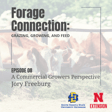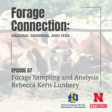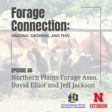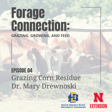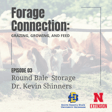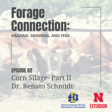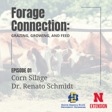Become a Creator today!Start creating today - Share your story with the world!
Start for free
00:00:00
00:00:01

Toxic Forages: Dr. Warren Rusche
Dr. Warren Rusche, extension feedlot specialist from South Dakota State University chats with us about toxicity problems that can arise with annual forages in the fall; prussic acid and nitrate toxicity.
Transcript
Introduction to Dr. Warren Rusci and Fall Challenges for Livestock
00:00:06
Speaker
It's The Porridge Connection, grazing, growing, and feed with your hosts, Ben. And Sarah. This morning we have Dr. Warren Rusci with us. He's the SDSU Extension Beef Feedlot Management Specialist. Warren's been with SDSU Extension for 18 years and most of that time he spent it in beef extension work. So he's got some experience in the field and is always someone fun to talk to. And today we've invited Warren to talk to us
00:00:34
Speaker
about some of those concerns we see in the fall. Every year in the fall, we have producers asking questions about prussic acid, nitrates, and other concerns with toxicities that we see surrounding livestock and specifically cattle. So, Warren, we want to welcome you this morning and kind of kick this off with some of those common toxicity and risk factors that we see with grazing animals and especially cattle
00:01:04
Speaker
in the fall?
Risks of Prussic Acid in Post-Frost Plants
00:01:06
Speaker
Well, Sarah, thanks for, and Ben, thanks for having me on. And you're exactly right. This is the, that it's that seasonal topic of, um, prussic acid, nitrate, all those kinds of things that, uh, pop up this time of year. And, and the part that I think is challenging is it, because it's a seasonal problem, um, it's not something we deal with all the time. So we have to go back and go back in the files, go back into memory bank and figure out how to deal with that.
00:01:34
Speaker
So Warren, as we kind of break this apart, because there are a couple of different issues that we have to deal with and take into consideration when we're grazing in the fall.
00:01:44
Speaker
I'd say grazing, I guess we probably have to take into consideration anytime we're harvesting forages here in the fall. Let's maybe jump into one of the first ones that comes to mind is, my mind is prussic acid. Especially we're sitting here where we've had a couple of frost, hard frosts come through and I know my phone's been ringing with those questions. I'm sure you guys have up north too.
00:02:06
Speaker
What do we need to really know about prussic acid and how can we make that forage still usable, still safe? Well, from a prussic acid standpoint, and you're right, that is a
00:02:22
Speaker
deal with that during that window right around that first killing frost. So what's going on? We're going to take a step back and think about what's going on in the plant physiologically. Anytime you have injury and frost is certainly an injury, the plant cells rupture and some different compounds within the plant combine and Sarah could probably
00:02:44
Speaker
I'm a knuckle dragon ruminant nutritionist, so I probably should not be talking too much about agronomic topics, and Sarah could probably answer this more expertly, but as those compounds combine, they form HCM, cyanide, prussic acid. If we called it cyanide, people would probably get a whole lot more concerned than they already are. As such, that's incredibly toxic to animals.
00:03:14
Speaker
And Ben, you touched on a little bit though that grazing versus harvesting. That's a key distinction, something really important to keep in mind. Because with the case of prussic acid, those gases will dissipate over time. So it's critically important for a few days right after the killing frost if they're grazing.
00:03:36
Speaker
if we're hating it or putting it up for silage, we have some opportunity for those toxic gases or toxic compounds to dissipate and get us to a zone of safety. So that's one of the questions that I think producers have to consider is are we grazing this or are we hating it? Because what we do, what our answer to that question is determines what our next steps might be. And Warren, I think
00:04:04
Speaker
That's some great advice because we really can't make decisions until we're thinking about, okay, what's the forecast, what's going to happen, and then making our next steps. And we've had some conversations recently about this. Some producers do some really creative things in trying to preserve the quality of the feed they have in the field because we know that these sorghum sedans and sorghums are, they can be great tools, right? But in the fall, we just see kind of a
00:04:33
Speaker
nightmarish situation when you're trying to make a decision of what to do with this high quality feed and you don't know if it's going to freeze hard enough or is it going to repetitively freeze. So what happens when we have a good hard frost versus a few light frosts in a row? So the few light frosts in a row to me are the higher risk
00:04:55
Speaker
event, or the more challenging one to manage around. You know, if we, if it were to, let's say get down to 25 degrees, kills the plant dead, we know, you know, now whatever happened is it's happened. And if we were grazing it, our book answer would be wait for seven days, then we should be fine.
Prussic Acid Management Strategies
00:05:15
Speaker
it's that series though of light killing frosts or borderline killing frosts that become challenging. We know that the lower portion or the smaller the plant is, the greater the potential risk. And so if we've got a situation where we've killed part of the plant, but not all of it, maybe the next night kills another part, then we ended up with that kind of that rolling
00:05:40
Speaker
stress event where it's really hard to tell when determine when we go from safe to risky back to safe again. So from that standpoint from a prosthetic acid management standpoint I would much prefer to deal with the hard killing frost where there's no doubt rather than the you know these lighter events that may cause some problems or we all know too that you know if you got you know
00:06:09
Speaker
varying heights, part of the more mature plant might be killed, but it didn't kill some of the newer regrowth down below. If they're grazing and they have the opportunity to go find that, that's where our risk is higher. That extended almost killing, but maybe not quite is, at least in my opinion, much more difficult, more challenging to deal with. You mentioned, Warren, what's happening in the plant. And sometimes people will ask,
00:06:35
Speaker
why does this happen when it freezes and why isn't this a concern on a day-to-day basis? And it's really a plant physiology thing. And that's why these questions are so hard to answer because sorghums and sedan grasses and sorghum sedans, sometimes even Johnson grasses on that list, they'll accumulate this. Like you said, it's basically turns out being cyanide in the end, but they accumulate in the outer tissue of the plant. And when there's something that comes in
00:07:04
Speaker
and causes the plant cells to rupture, those compounds combine and they lead to that prussic acid release, which is where we have this lethal issue. And so frost is one of those things that can cause those plant cells to rupture and anything else that causes rupture like crushing and trampling actually can do something similar, but freezing gets the whole plant. And then we're worried about the different parts of the plant tissue. You know, the leaves, like you said, if it's a very short plant,
00:07:31
Speaker
It could be much more affected because it's going to be more concentrated. And we just don't know what those animals grazing out there. So what are some of the options that you talk to producers about when they're trying to determine whether to continue grazing or do something different? What is that something different we could try if we don't want to wait that seven days?
00:07:54
Speaker
Well, as it turned out, I just had this conversation with a consultant yesterday and it was that comp, you know, do we raise it, don't we? There's a lot of material out there and what.
00:08:06
Speaker
what they were leaning towards doing, and which sounded like a really good idea, and I was fully supportive of it, was to, they were gonna cut it down and either bail it or perhaps just swath graze that for later. In which case, in both of those cases, giving that a little bit of time, again, you know, prussic acid, the solution to this problem is time.
00:08:33
Speaker
We'll talk about nitrates a little later. Their time doesn't help us. So with prussic acid, my
00:08:41
Speaker
If we're not going to harvest it, or if that's not an option, my default has always been get the kettle off. Because if you read theoretically, there's a treatment. Practically speaking, you're not going to get there. You'll never get there in time. These products are not things we have on our shelves. You'd have to have a vet. The vet's not going to get there in time. The animal dies.
00:09:04
Speaker
So from a practical standpoint, our solution is we just pull the cattle off and take the wait and see approach. And then it's also, and then reintroducing them, or then we do some of those standard kinds of things whenever we turn livestock onto something that may be suspect.
00:09:28
Speaker
Don't let them don't turn them out hungry Maybe limit time, you know do some of those, you know There may be some some management things that we do to acclimate those but you know the the safest answer is Get them off there Sometimes what you know, I know Sarah and I you had this convert you and I had this conversation Where it was sort of sedan on the outside and some other covers on the inside and how do we deal with that? I think you know, there's a
00:09:59
Speaker
Some of this is the sorghum sedans or the forage sorghums work great in a lot of these cover crop mixes. I think one of these things is how do we incorporate those in thinking of terms of risk. And silane will also help. Again, it's that time issue. Some of it is part of the fermentation process. I think some of that cyanide gets used up or it dissipates out. Either way,
00:10:28
Speaker
we have some length of time from the time of when that gas accumulated to when it's actually being fed the livestock and so chopping it for silage could work really really well. It also you know
00:10:43
Speaker
You know, the sorghums are kind of challenging sometimes to harvest in, in siling because they're too wet. So in some ways having a frost might actually help us out a little bit, uh, by making it a little easier to handle, um, from a, you know, from a dry down standpoint. So yeah, that harvesting it is through the, through an in siling process would be a great way to use this, this feed stuff. I guess before we jump off of the, the prussic acid topic here, just to add a little bit of clarity.
00:11:12
Speaker
We've thrown out sorghum, sedans, sorghums. Prussic acid is really a little bit limited when we talk about impacts to a certain group of plants, correct? We're talking about all of our sorghum species, sedan grass. You mentioned Johnson grass, Sarah. It's not something if we have millet, if we've got oats, we've got a brassica. We have all these different cover crop mixtures anymore.
00:11:41
Speaker
can't name everything in it. So it's worth sometimes going through that seed list and looking and seeing, okay, do we have something that's in that sorghum family? Okay, we need to be worried about prussic acid at this time of year. Or, oh, nope, we chose to leave those out maybe because we knew we were going to use them for a fall grazing. And then that's not something that we necessarily have to have as high a concern with.
00:12:05
Speaker
You're right. It's mostly an issue with the sorghum family. I was even doing some reading that even the pure sedan grasses are less susceptible than the sorghums. So, as we think then though about grazing resources, that might become part of the thought processes. Do I have
00:12:26
Speaker
Maybe I've got some areas we can graze that have no sorghum in it whatsoever that become the place, the refuge, so to speak, for whenever that killing frost window hits that I've got a place to go with the whole herd.
00:12:43
Speaker
We'll see what happens with the rest in terms of killing frost. So that, I don't know if we talk about that much and, you know, and in my day-to-day world, I deal with everything. It's already been harvested, so it's easy. But, you know, that might be something worth taking a look at is, you know, do I have a portion of the cover crop or annual forage plantings, not including sorghums or sedan grasses as a way to mitigate some risk?
00:13:13
Speaker
And as a forage person sitting here with a couple guys that are great with livestock, I think we would all say that we don't want people to be afraid to use sorghums or sorghum sedan grasses. They're a great tool. It's great feed. Um, you know, if you're trying to improve your soil health from an agronomy standpoint, it's an awesome cover crop, but you really just have to think twice in the fall.
00:13:43
Speaker
Yeah, my my bias would probably be to, you know, depending on when that was planted to be looking at that as a here in South Dakota is in August, September, July, August into September kind of grazing resource and have it fully utilized before frost. You know, and then perhaps it'd be either some
00:14:05
Speaker
winter annuals, if there was enough growth or some other feed stuffs I could move on to later to avoid some of that frost window. Warren, one thing we haven't mentioned is regrowth. So when we have issues with prasic acid and let's say that the producer is swath grazed or cut it for hay or silage and we have a frost, even standing plants that have just had some grazing on them, we get that frost and then they want to regrow if it wasn't a hard enough frost.
00:14:35
Speaker
Uh, there's some risk factors there and we'll let you touch on them. Sure. Yeah. That regrowth. Um, so I was just, as we're talking, I was scrolling through some of our recommendations. And one of the things we put out is, uh, you know, just don't graze sedan grass or those hybrids until the plants are at least 18 to 24 inches tall, uh, because the shorter plants have an increased, uh, risk.
00:15:00
Speaker
of having prussic acid issues. So that is the challenge. And I would be especially careful grazing the short regrowth. That might be an instance where, let's say we did the swath graze or we simply bailed it, that maybe probably the easiest approach is to just leave that alone until it is fully killed, dead,
00:15:29
Speaker
we've been down to 20 degrees, there's no more regrowth, let it wait a few days, then that becomes some potentially valuable grazing that we can do later in the winter or later in the fall. We've removed the risk because it's not regrowing anymore, given enough time so that there isn't an issue with the prussic acid accumulation, and it then becomes another place for
00:15:57
Speaker
either we can graze it off or we can just simply leave that and let it become a, you know, add to the soil organic matter. But I would be, this time of year, I would plan on, if I'm going to cut it, we're done. I think because of that regrowth issue, at least until after we've got a fully killing frost that dries the plant all the way down. And we were just discussing this with another sorghum
00:16:24
Speaker
Contact, if you will, Jeff Jackson and I and Warren were talking about this last week. And one of the suggestions with the swath grazing concept is, okay, we can preserve the quality of the speed if we swath it right now before the frost, but we want to leave. And this is not an exact science, but at least at minimum 24 hours between the time we swath it and the time it freezes, because it needs to wilt.
00:16:49
Speaker
Because if that plant is still green and it freezes, it can still go through some of this cell rupturing process because it's still got water in the plant. So if we can let it wilt for, you know, this was a, it's a rough science. We don't have data on this, but it needs to wilt for a while, at least 24 hours before it freezes, or you might have some of those same, you know, wait seven day issues. And then you don't want to, you don't want to cut it too soon either, because you cut it too soon and you're going to have regrowth before the frost.
00:17:18
Speaker
Despite that being a warm season plant, those grasses are great at regrowing when they're grazed or they're cut, even though it's cold, they are so good at coming back. So we just got to watch that.
Understanding and Managing Nitrate Risks in Grazing
00:17:31
Speaker
We've been looking at something very specific with our sorghum species with prussic acid, something that's maybe a little bit more broad that we still have to take into consideration when we're talking about grazing this time of year are nitrates.
00:17:44
Speaker
Can you just give us a really brief introduction, Warren, to why nitrates are a concern in the fall in particular, and maybe some things that we need to take into consideration in that management side?
00:17:59
Speaker
So yeah, you're right, Ben. Nitrates often get lumped together with prussic acid at this time of the year, partly because the symptoms are, well, frankly, the symptoms, a lot of cases are sudden death. They affect some of the same plant species, forage, sorghums, and sedans. Both of them are maybe more of a challenge with grazing livestock. And so we often think about those two together.
00:18:27
Speaker
From a management standpoint, though, there's some very key differences between the two. First and foremost, as I said earlier, time is our friend with prussic acid, especially either we can either wait it out to graze it or harvest it, give it some time to dissipate and the problem solved.
00:18:43
Speaker
Nitrates don't go away unless we can reduce that by putting it into the silage pile and getting a good fermentation. But if it's there and the frost kills the plant off, we have nitrates, period. So what nitrates, we talked about prussic acid is essentially cyanide gas, which we all recognize as a poison.
00:19:09
Speaker
Nitrate, it all depends on how it's metabolized in the rumen. In the rumen, it goes from nitrate to nitrite. Nitrite is what crosses into the bloodstream and affects the animal's ability to carry oxygen. Cattle, a ruminant, can handle a certain amount of nitrate before it essentially overwhelms the system and then
00:19:36
Speaker
all too much nitrite builds up. And I know when we're talking off camera that you'd had Dr. Dronowski on your program, she's done some work on grazing with these cover crop mixes where really questioning whether or not our book values are in fact as accurate as they could be perhaps for grazing livestock.
00:19:57
Speaker
I'm not going to get into that too far because she's the expert and you've already talked to her. But I think anecdotally, we've all talked to people using cover crop mixes that have gotten along, even though some of those lab tests would say perhaps there's a problem. And I think it comes down to smaller meal sizes, giving that animal a little more time to metabolize that.
00:20:22
Speaker
from a should also back up when I said nitrates can be a problem year-round and it really what it what happens is we got the animal that's taking up soil nitrate into the plant in order to produce amino acids and plant protein
00:20:40
Speaker
If there's something along the way that slows that process down, and again, Sarah's the agronomist, so if I'm getting too far off, she'll correct me. But if there's anything that slows that process down and essentially traps it as nitrate somewhere in the plant, that's where we start having problems from a livestock standpoint. So that could be something like drought, any kind of plant stress, or frost. And so when I think of nitrates,
00:21:10
Speaker
I'm a little concerned sometimes with the stand grasses and the forage sorghums. I get especially concerned with oats. As a sidebar, if someone asks me, I've got oats and I'm worried about it, I want to tuck them into chopping it for oatlage and skipping hay altogether. The fermentation process does a pretty good job of
00:21:33
Speaker
converting nitrate into amino acids or ammonia or something that doesn't pose a toxicity problem. So with any crop, that's my default position. If we have to salvage it, that's where chopping it for silage really works well.
00:21:52
Speaker
Now we do have to make sure we've done everything right. Um, you know, one of my, in quite a few years ago now at this point, but when we had the drought of 2012, uh, one of my coworkers had talked to a producer where they chopped it too wet, didn't ferment well. And the actual test of nitrates went up, not down. Uh, so, you know, we do need to make sure if we're doing that, we're doing everything correctly.
00:22:18
Speaker
But that ensiling process is really kind of the go-to as far as dealing with higher nitrates and feeds. And Warren, we need a full ensiling to, I mean, the full fermentation to really get the most benefit out of that. I know sometimes producers are a little stretched on feed and we chopped and you want to open that pile up a little early.
00:22:42
Speaker
we really need to resist that temptation. Yeah, you need to let that go the full 30 days or just a little longer to let all of those biochemical reactions take place and take care of the problem. So that could be an instance though too is where if you've done some testing ahead of time and kind of know where you're at, then that may give you a little bit of safety.
00:23:08
Speaker
Um, you know, if, for instance, you know, you know, if you knew it was only 300 parts per million, that's less risky than some other options. The challenge with, I think with anything with nitrate is because you've got that variability within the field, you might have some, you know, I think of the, the Rocky Noel that just didn't grow well or areas that, you know,
00:23:31
Speaker
where there's some water drainage issues and depending upon what part of the field got chopped where and where that is in terms of the silage mass may affect whether or not that's going to be an issue. Probably less of an issue with silage simply because of the way we
00:23:50
Speaker
harvest that and store it where it ends up, you know, we're taking a bigger area to put it into a truck load, then we, or wagon load, then we put a lot of wagon loads and truck loads and mix that together and pack that down and layer everything. Uh, and then we come in with the front end loader and take a, take six inches off of the entire face of something that probably took us all week or maybe several days to actually get harvested. So I think it blends it out fairly well.
00:24:18
Speaker
I'd be more concerned about a dry bale. If that bale happened to be primarily from a poor spot in the field, our lab test is only as good as the sample we took.
00:24:30
Speaker
And if our sample wasn't a real representative, or if we've got a lot of variability in a field, we could get ourselves caught. So these kinds of questions, as we're talking about this, I've got another window open on my computer that has my materials on prussic acid and nitrate, because I've been doing this quite a while, but I still don't trust my memory because of the fact that it's seasonal, don't see it all the time.
00:24:57
Speaker
And the consequences being wrong can actually be pretty high. I think that's a great point, Warren. And it's kind of ever-changing. If we have nitrates in feed, that doesn't necessarily mean we can't feed it, right? There's levels. And you mentioned testing. And it depends on how many parts per million that feed is at as to who we can feed it to, what class of livestock we can feed it to.
00:25:26
Speaker
how much they can get of it. And I know we discussed earlier this year, you and I were discussing that not all those charts are the same. And so there's maybe some more research that needs to be done on that, but there is kind of a general understanding. And maybe you want to talk about that a little bit of how we blend feeds and who we give them to who do have nitrates.
00:25:48
Speaker
So the big, you're right, Sarah, and I'm glad you brought it up because I'd kind of forgotten that how depending on whose source you looked at, uh, some of those risk categories change a little bit, but, um, with nitrates, um, the quick answer is the solution is dilution. Uh, the more we dilute it out, the less problems we are. We have also the pregnant animals are much higher risk than non pregnant animals.
00:26:17
Speaker
And so if you've got a choice, um, you know, if you're a cow calf slash cattle background or here in Nebraska, the Dakotas, you know, I've got some feed stuffs that are maybe a little questionable. I'm putting that in the, the background and cattle diet and not to the bread cows or, you know,
00:26:40
Speaker
or not to, those bales of hay get ground for young stock, not those bred cows in the third trimester, or I save that, or I save it until after we get done calving and start doing some strategy. As you're talking about that, I had a phone call a few years ago from a horse breeder in South Dakota, pretty prominent within that industry, wanting to know what the tolerances for nitrates for horses were.
00:27:10
Speaker
And of course, I had absolutely no idea. I don't know if anyone's done the research. And what I finally asked him, I said, are you planning on feeding this to bread mares? And he said, yeah, I'm going to have to. We're short on feed. I said, I wouldn't do it. I wouldn't touch it. I said, because I can guarantee you if you do that, the mare that will abort is the one that's carrying the $50,000 cold. And he said, yep, you're right. So sometimes, with some of these, it's a little bit of a risk reward.
00:27:38
Speaker
you know how much are we risking versus what the reward is that was an extreme example you know that's a an operation that you know could very well produce colts itself for that kind of money um you know if i'm feeding you know
00:27:54
Speaker
Some backgrounded calves, my risk level is much different. And I can probably dilute that. I was probably going to dilute those feeds anyway. And so I'm not as concerned. So I guess the point of that was as we
00:28:09
Speaker
We've got those risk categories, but what we can really think about is, you know, think about risk in a very broad sense that, you know, prioritizing the bred females within the herd and saving some of the suspect feed to dilute it out to go to the young stock. And in those cases, our danger then becomes if we run into hotspots. So like, you know, I've run into instances where oat straw tested too high.
00:28:39
Speaker
that becomes real challenging because, you know, probably needed for bedding and, you know, there's some things that go on. I think, you know, I don't know if that person used it or not. I suspect they did. I don't know if they were careful not to put it out with cows or not. But my suspicion is that, you know, a cow isn't going to suddenly slug feed 30 pounds of straw.
00:29:05
Speaker
And so if they did consume some of it, it was in small enough doses that they got away with it. Don't mishear what I just said. So we do still want to be careful about the levels. But it can be a complex decision as weighing that risk reward versus when we use some of these feedstuffs. I really like.
00:29:34
Speaker
how you're presenting that, Warren, just thinking about it as a, you know, understanding what that risk level is, how much can we tolerate in our operations? And then, you know, how can we manage that risk somewhat? And I appreciated what you said about sampling and, excuse me here, I appreciate what you said about sampling, you know, getting a
00:29:58
Speaker
we talk about sampling our hay and making sure that we do that. And it's really easy to just plug a few bales at the end and call it good, but we have to get a really well representative sample if we really want to capture what's going on out there. And so that helps us understand that risk. The tough part of this, sometimes it also depends on how short a feed we are. If we've got all kinds of feed resources, these decisions aren't necessarily as challenging as when
00:30:26
Speaker
our option is no feed or a bunch of oat hay that test too high. So it comes back to that, the more we can diversify our feed supplies, the more options we have. Some of this might be some of the best arguments for buying mixer wagons of anything that we run into because the ability to mix this off, dilute it with something else,
00:30:50
Speaker
really could, it could really make some what otherwise would be very not terribly valuable feed into something useful. And I guess one other question that I might throw your way, Warren, when we're talking about utilizing this, then we really need to be considerate of the entire diet. You know, just one feed stuff, you know, if we're just have some hot bales, but that's a small portion of that entire diet, or I know
00:31:19
Speaker
I'll get questions sometimes about high nitrates and water sources and how that plays into the factor. But it's that big picture, correct, that we need to take into consideration. That's right. If we're dealing with water that's also high nitrate, that just adds to the load that our livestock are dealing with. Good news is I don't think, by and large, that by itself isn't the problem.
00:31:48
Speaker
And I don't know if I've honestly run into that where we had that combination of high nitrates plus high nitrate feed. But if we were pulling water out of shallow wells that
00:32:01
Speaker
you know, we're suspect, that could add to the problem as well. So that also makes some of this, some of those recommendations we might lean towards, you know, being a little more cautious than not, just because of, you know, we'd want to be careful, we're not getting too close to the edge where we're perhaps inducing some abortions. And you bring up another good point, Warren, we probably don't have time to cover it today, but testing water quality any time of year
00:32:31
Speaker
is important too. And that's a pretty simple test that you can get a hold of or bring a water sample in. I know in South Dakota, you can bring a water sample to many of our extension regional centers or county offices. And I'm assuming that, you know, there's other places in the Midwest, of course, any lab can do that too. So another important thing to keep in mind is those water levels.
00:32:57
Speaker
Yeah just you know getting a kind of a baseline in terms of you know I know we've been talking nitrates and prussic acids this morning but things like minerals and so forth it's good to know what we're dealing with if we're dealing with a lot of sulfate or some other antagonisms you know that's going to inform what we might want to do or have to do from a mineral standpoint so
00:33:19
Speaker
We tend to ignore water.
Ensuring Water Quality and Upcoming Forage Association Meeting
00:33:21
Speaker
Um, and it's, I guess it's just not a, uh, sexy, glamorous topic, but it's critically important, but it, yeah, you're right. Uh, we don't pay them off attention as much attention to it as we ought to. Well, it's like we said, they drank it and they didn't die. So we don't think about it. It's just not something we think about regularly. Sarah and I are building up quite the list of.
00:33:47
Speaker
topics that we need to revisit. So that sounds like it's another one that we're going to have to come back to. Well, Warren, is there anything that we've missed or any other things that we need to take into consideration you think as we consider using some of these forages as a fall feeding source?
00:34:05
Speaker
You know, I think we've covered everything pretty well. And what I hope the takeaway is, isn't to scare producers off away from using it. It's that, you know, we can make excellent use of these feedstuffs. We just have to, there's a few things we have to keep in mind at this time of year in terms of management. One final thing that might be a bit off topic that we did want to mention yet today is the first annual meeting of the Northern Plains Forage Association coming up on December 1st.
00:34:34
Speaker
This is a group that you, Sarah, started about a year ago and has been a great resource for producers in southeast South Dakota and the surrounding area. This year's meeting will be held in Brandon, South Dakota at the Holiday Inn Express on December 1st from noon till 4 o'clock p.m. Dr. Dan Under sander emeritus professor from the University of Wisconsin will be speaking on leaf loss effects on alfalfa yield and quality. Rebecca Kern-Lunberry of Ward Laboratories will be talking about NIRS evaluation of grass rations.
00:35:02
Speaker
Producer Brady Wolf will discuss alternative forages and grain rotations, and Dr. Peter Sexton of South Dakota State University will cover fitting soil health into forage production. The annual Northern Plains Forge Association annual business meeting will also be held at this time, and CCA credits are available.
00:35:21
Speaker
Cost is free to Association members and $10 for all other participants. You can sign up by visiting extension.sdstate.edu slash events or emailing npforage at gmail.com. Well Warren, we appreciate you taking some time to join us and talk to us today. And we just thank all of our listeners for joining in as well, joining us here on the Forage Connection.
